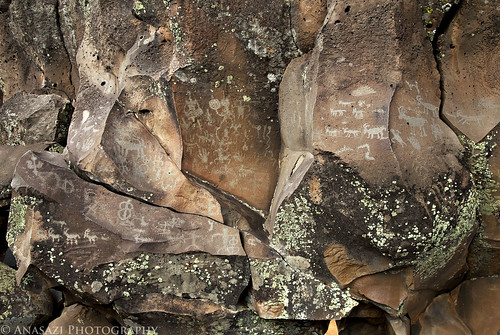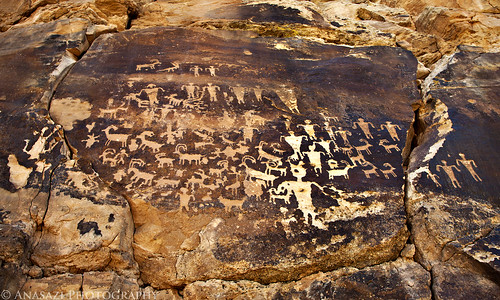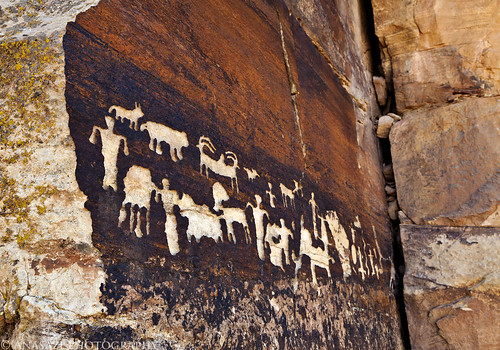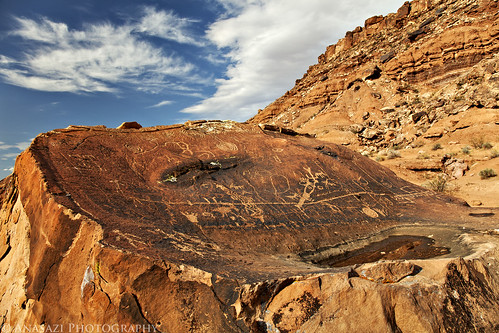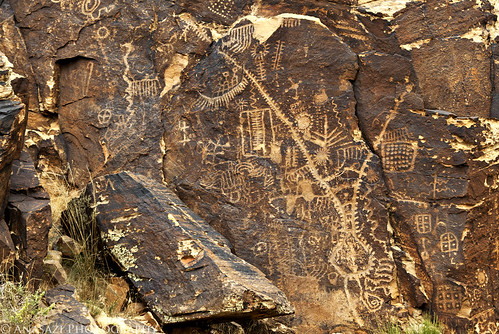After leaving Paiute Cave we found our way over to Nampaweap to explore the countless petroglyphs found all over the boulders and cliff faces in the area. Nampaweap means “foot canyon” in Paiute. This canyon may have been an important prehistoric travel corridor from the Grand Canyon to the resources of the ponderosa pine country around Mount Trumbull. This is also one of the largest known rock art sites on the Arizona Strip. This photo shows a typical scene found at Nampaweap. There are plenty of boulders, petroglyphs and lichen in the area. We found a lot of petroglyphs on our visit, but I’m sure we probably missed many of them, too. This site will definitely require another visit or two when I have the chance.
Busy Sheep Panel
Yesterday I posted a photo from Canaan Gap, and I’m going to do the same today. I wasn’t expecting too much when I planned to visit this site, but I was pleasantly surprised to find many cool petroglyphs when I arrived. This was the largest panel at the site, and it kind of reminds me of the Great Hunt Panel in Nine Mile Canyon because of the way the figures are all grouped together. Another interesting figure in this panel is the upside down anthropomorph located all the way on the left side.
Canaan Gap Petroglyphs
On the second day of our trip last week, we stopped at this petroglyph panel located near the Canaan Gap before heading down into Arizona. Not only is this a pretty interesting panel located on a flat colorful cliff face, but it appears that some kind of erosion over the years has caused these petroglyphs to become much deeper than they originally were, since I doubt they were carved this deeply. This is the first time I have come across a set of petroglyphs like this. Very cool!
Boulder Top Petroglyphs
After spending some time at the Parowan Gap earlier in the day, we continued south to the Arizona Strip. Our next destination was to visit the petroglyphs on the boulders at the base of Little Black Mountain. This was one of the more unique panels at the site. It appears that this boulder contains a natural pothole that holds water which might be why it was an important place. The top of this boulder contained more petroglyphs than the others in the area. On a side note, this is the first rock art site I have visited in Arizona, which also means I have visited sites in all of the four corner states this year.
Zipper-Glyph
I just got home late on Saturday night from spending the previous week on a trip in Southern Utah and Northern Arizona. One of the main goals of this trip was to visit some new rock art panels and sites. On our drive south, the first location we stopped at was the Parowan Gap. There are many petroglyphs located in this gap in the Red Hills west of the Parowan Valley, but the Zipper-Glyph is probably the most well-known. Some believe that the large zipper-like figure, that is the focus of this panel, represents some kind of map or calendar system….or both. The shape sure does resemble the Parowan Gap in which it is located. This was a great first site to visit on the week-long trip. I’ll be posting more from the trip in the upcoming weeks.
